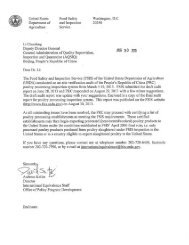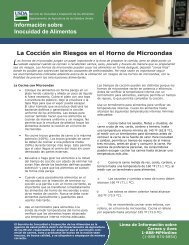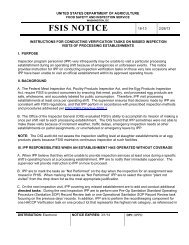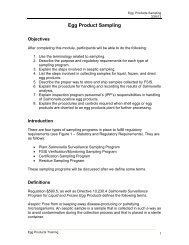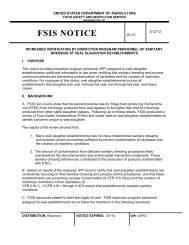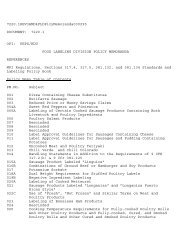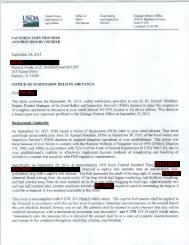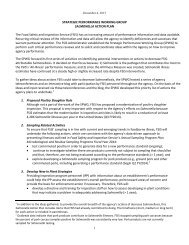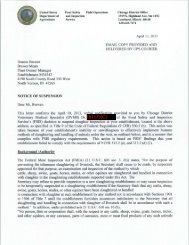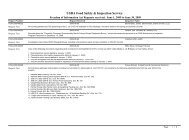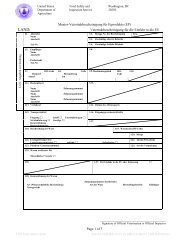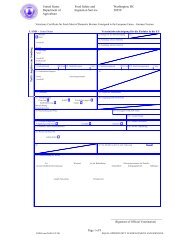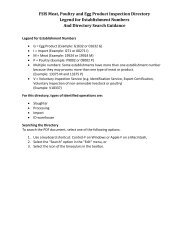Ready to Eat and Shelf Stable Products Process Familiarization
Ready to Eat and Shelf Stable Products Process Familiarization
Ready to Eat and Shelf Stable Products Process Familiarization
You also want an ePaper? Increase the reach of your titles
YUMPU automatically turns print PDFs into web optimized ePapers that Google loves.
RTE-SS <strong>Process</strong> <strong>Familiarization</strong><br />
8/15/13<br />
<strong>Ready</strong> <strong>to</strong> <strong>Eat</strong> <strong>and</strong> <strong>Shelf</strong> <strong>Stable</strong> <strong>Products</strong><br />
<strong>Process</strong> <strong>Familiarization</strong><br />
Many processors combine nonmeat ingredients <strong>and</strong> raw meat or poultry for<br />
further processing in<strong>to</strong> <strong>Ready</strong> <strong>to</strong> <strong>Eat</strong> (RTE) or shelf stable (SS) products. This<br />
module reviews important process steps <strong>and</strong> fac<strong>to</strong>rs that must be controlled <strong>to</strong><br />
meet st<strong>and</strong>ards for safety <strong>and</strong> product identity.<br />
Objectives<br />
1. Define <strong>Ready</strong> <strong>to</strong> <strong>Eat</strong><br />
2. Define <strong>Shelf</strong> <strong>Stable</strong><br />
3. Identify process steps that relate <strong>to</strong> the safety of fully cooked-not SS, heat<br />
treated-SS, <strong>and</strong> not heat treated-SS products<br />
4. Identify fac<strong>to</strong>rs requiring control at key process steps <strong>to</strong> meet st<strong>and</strong>ards<br />
for safety <strong>and</strong> product identity<br />
Introduction<br />
This module covers common processing steps for products in the following<br />
HACCP processing categories:<br />
1. Fully Cooked-Not <strong>Shelf</strong> <strong>Stable</strong>. This category applies <strong>to</strong> establishments<br />
that further process products by using primarily a full lethality heat process<br />
step (e.g. cooking) <strong>to</strong> achieve food safety. The finished products are not<br />
shelf stable <strong>and</strong> must be frozen or refrigerated for food safety purposes.<br />
These products also meet the definition of <strong>Ready</strong> <strong>to</strong> <strong>Eat</strong> as defined in 9<br />
CFR 430.1.<br />
<strong>Ready</strong> <strong>to</strong> <strong>Eat</strong> (RTE) product is a meat or poultry product that is in a form<br />
that is edible without additional preparation <strong>to</strong> achieve food safety <strong>and</strong><br />
may receive additional preparation for palatability or aesthetic, epicurean,<br />
gastronomic, or culinary purposes. RTE product is not required <strong>to</strong> bear<br />
safe-h<strong>and</strong>ling instructions or other labeling that directs that the product<br />
must be cooked or otherwise treated for safety, <strong>and</strong> can include frozen<br />
meat <strong>and</strong> poultry products.<br />
2. Heat Treated-<strong>Shelf</strong> <strong>Stable</strong>. This category applies <strong>to</strong> establishments that<br />
further process by using a heat treatment processing step <strong>to</strong> achieve food<br />
safety in combination with curing, drying, or fermenting processing step <strong>to</strong><br />
achieve food safety. The finished products are shelf stable <strong>and</strong> not<br />
required <strong>to</strong> be frozen or refrigerated for food safety purposes.<br />
_____________________________________________________________________________<br />
Inspection Methods 1
RTE-SS <strong>Process</strong> <strong>Familiarization</strong><br />
8/15/13<br />
<strong>Shelf</strong> <strong>Stable</strong> (SS) product is free of microorganisms (pathogens <strong>and</strong><br />
spoilage) capable of growing in the product at nonrefrigerated conditions<br />
at which the product is intended <strong>to</strong> be held during distribution <strong>and</strong> s<strong>to</strong>rage.<br />
3. Not Heat Treated-<strong>Shelf</strong> <strong>Stable</strong>. This category applies <strong>to</strong> establishments<br />
that further process by curing, drying, or fermenting processing step as the<br />
sole means by which product achieves food safety. Establishments in this<br />
category may apply a low-level heat treatment as long as the heat<br />
treatment is not used as means <strong>to</strong> achieve food safety. The finished<br />
products are shelf stable <strong>and</strong> not required <strong>to</strong> be frozen or refrigerated for<br />
food safety purposes.<br />
Fully Cooked-Not <strong>Shelf</strong> <strong>Stable</strong> Example: Hotdogs<br />
One of the major product groupings under the Fully Cooked-Not <strong>Shelf</strong> <strong>Stable</strong><br />
category is cooked sausages. There are many different types of cooked<br />
sausages. Some common examples are bologna, cooked salami (a.k.a., cot<strong>to</strong><br />
salami), polish sausage, <strong>and</strong> hotdogs. Let’s take a closer look at hotdogs as an<br />
example of how these products are produced.<br />
The first steps are meat <strong>and</strong>/or poultry, other ingredients, <strong>and</strong> packaging<br />
materials are received <strong>and</strong> s<strong>to</strong>red in the establishment until ready <strong>to</strong> use. Many<br />
establishments carefully control the quality of the incoming ingredients through<br />
purchasing specifications. Meat ingredients may have quality specifications such<br />
as percent fat, moisture, <strong>and</strong> protein. These are parameters that will affect the<br />
final quality of the product.<br />
Raw meat ingredients used in these products will depend on the type of<br />
finished product desired. Not long ago, most hotdogs were either a combination<br />
of pork <strong>and</strong> beef, or they were all beef. Today, establishments still make these<br />
products, but many more combinations of ingredients are used. Many<br />
formulations include at least some poultry products (turkey or chicken), <strong>and</strong><br />
some products are made exclusively with poultry.<br />
The first step in the formulation process is weighing or measuring the meat<br />
<strong>and</strong>/or poultry ingredients. They are ground <strong>and</strong> mixed or blended with the nonmeat<br />
ingredients. Often establishments will pre-blend, that is, they will grind <strong>and</strong><br />
mix the meats with water <strong>and</strong> salt, <strong>and</strong> sometimes with the nitrite, <strong>and</strong> let it st<strong>and</strong><br />
for a period of time in a cooler.<br />
Antimicrobial agents, are substances such as acetates, diacetates, <strong>and</strong><br />
lactates, added <strong>to</strong> an RTE product <strong>to</strong> reduce or eliminate a microorganism,<br />
including a pathogen such as L. monocy<strong>to</strong>genes, or suppress or limit growth of L.<br />
monocy<strong>to</strong>genes in the product throughout the shelf life of the product.<br />
_____________________________________________________________________________<br />
Inspection Methods 2
RTE-SS <strong>Process</strong> <strong>Familiarization</strong><br />
8/15/13<br />
Binders <strong>and</strong> extenders, such as dry milk powder, cereal flours, <strong>and</strong> soy protein,<br />
have a number of uses in a sausage formulation. They increase the overall yield,<br />
improve binding qualities, <strong>and</strong> add certain flavor characteristics.<br />
Cure. Meat is cured with the addition of nitrite or nitrate, usually sodium nitrite,<br />
often added in a salt <strong>and</strong> cure mixture. When nitrite is added <strong>to</strong> the meat mixture<br />
it combines with the meat pigment, myoglobin, <strong>to</strong> form the characteristic pink-red<br />
color of cured meat.<br />
Cure accelera<strong>to</strong>rs, such as ascorbates <strong>and</strong> erythorbates, are used <strong>to</strong> speed up<br />
the curing process. They also stabilize the color of the final product.<br />
Phosphates are used <strong>to</strong> improve the water-binding capacity of the meat, <strong>and</strong><br />
contribute <strong>to</strong> the flavor <strong>and</strong> color of the product.<br />
Spices <strong>and</strong> flavorings are used <strong>to</strong> add flavor <strong>to</strong> the sausage. The wide range of<br />
available spices, seasonings, <strong>and</strong> flavorings is a primary reason for the variety<br />
available in sausages in the marketplace.<br />
Spices are any aromatic vegetable substance that is intended <strong>to</strong> function as<br />
contributing flavor <strong>to</strong> food, rather than as a nutritional substance. The active<br />
aromatic or pungent properties of spices that contribute the most <strong>to</strong> the<br />
flavoring effect are present in the volatile oils, resins, or oleoresins of the<br />
spice. Spices may be used whole or ground. White pepper, paprika, <strong>and</strong><br />
nutmeg are common spices used <strong>to</strong> produce the characteristic flavor of the<br />
hotdog. Because paprika also adds color <strong>and</strong> makes meat look brighter red, it<br />
must be listed as “paprika” on labels.<br />
Flavorings are substances that are extracted from a food, <strong>and</strong> contribute<br />
flavoring, such as spice extracts.<br />
After the non-meat ingredients are blended with the ground meats, the mixture is<br />
emulsified. This is done in an emulsifier, <strong>and</strong> further reduces the size of the<br />
meat particles <strong>to</strong> achieve a very fine texture. Fat, protein, salt, <strong>and</strong> water are<br />
mixed <strong>and</strong> combined in<strong>to</strong> a semi-fluid emulsion. The meat muscle protein,<br />
myosin, is solubilized, or released from the muscle fibers. The solubilized<br />
protein <strong>and</strong> water combine <strong>and</strong> surround the fat globules, <strong>and</strong> suspend the fat<br />
particles within the mixture.<br />
Careful control of the amount of each ingredient is essential <strong>to</strong> the quality of the<br />
final product. The manufacturer must select a mix of raw meat materials with the<br />
appropriate binding characteristics. Different meats vary in their ability <strong>to</strong> bind.<br />
Lean beef, for example, bull, cow, <strong>and</strong> shank meat, has high binding ability.<br />
Regular pork or beef trimmings with more fat, <strong>and</strong> poultry, have medium binding<br />
ability. Low binding meats contain high levels of fat, such as jowls <strong>and</strong> briskets.<br />
Organ meats have no binding qualities.<br />
_____________________________________________________________________________<br />
Inspection Methods 3
RTE-SS <strong>Process</strong> <strong>Familiarization</strong><br />
8/15/13<br />
After emulsification, the mixture (or “batter”) is stuffed in<strong>to</strong> casings, usually<br />
artificial plastic casings that allow moisture <strong>to</strong> cook out <strong>and</strong> smoke flavors <strong>to</strong><br />
penetrate. Natural casings such as sheep small intestines may also be used.<br />
Following stuffing, the product is linked by pinching <strong>and</strong> twisting the casing <strong>to</strong><br />
form separate units of sausage. The sausages are still held <strong>to</strong>gether by the<br />
casing. These lengths of casings are then placed on racks or trees, <strong>and</strong> are<br />
ready <strong>to</strong> be loaded in<strong>to</strong> the smokehouse. Some establishments load trees in<strong>to</strong><br />
individual smokehouses, however, some large volume establishments use<br />
continuous smokehouses.<br />
The smokehouse parameters that must be controlled are temperature, time, <strong>and</strong><br />
humidity. Although other documentation can be used <strong>to</strong> support the adequacy of<br />
the cook step, many processors follow the parameters in Appendix A. The<br />
product must be exposed <strong>to</strong> a high enough temperature in order <strong>to</strong> produce a<br />
fully cooked, ready-<strong>to</strong>-eat product. The temperature inside the smokehouse, <strong>and</strong><br />
the internal temperature of the sausage, may be moni<strong>to</strong>red by the establishment<br />
in order <strong>to</strong> verify that the critical limits are met. Cooking is a very important step,<br />
because it is here that any pathogens (e.g., Salmonella) that may be in the<br />
product will be eliminated <strong>and</strong> the numbers of spoilage bacteria will be lowered <strong>to</strong><br />
an acceptable level. This is called a lethality treatment.<br />
After product has reached the final temperature desired, the cooling process<br />
begins. Many processors use Appendix B <strong>to</strong> support that their cooling process<br />
will prevent pathogen growth. This product is often showered with cold water<br />
inside the smokehouse. This removes some of the heat from the product, <strong>and</strong><br />
immediately halts the cooking process. The shower is usually not sufficient <strong>to</strong><br />
complete the cooling process. Usually product is moved <strong>to</strong> another chiller or<br />
cooler <strong>to</strong> finish cooling. Some establishments use very cold water as a chilling<br />
medium, sometimes with salt added <strong>to</strong> lower the temperature below the normal<br />
freezing point of water. This is called a brine chiller. Other establishments may<br />
use cold air, <strong>and</strong> some use a combination of methods.<br />
The cooling process is also known as stabilization. There are two types of<br />
bacterial contamination that must be addressed by the stabilization process.<br />
Spore-forming bacteria (Clostridium perfringens <strong>and</strong> Clostridium botulinum)<br />
can survive cooking when in the heat-resistant spore form, <strong>and</strong> these<br />
organisms need <strong>to</strong> be considered as the products are chilled. Growth<br />
(sometimes referred <strong>to</strong> as “outgrowth”) of these bacteria is slowed by rapid<br />
cooling. Cooling rates, or time/temperature relationships, must be carefully<br />
controlled in order <strong>to</strong> ensure that product does not remain at warm<br />
temperatures that would support the outgrowth. Excessive dwell time in the<br />
range of 130° <strong>to</strong> 80°F is especially hazardous, as this is the range of most<br />
_____________________________________________________________________________<br />
Inspection Methods 4
RTE-SS <strong>Process</strong> <strong>Familiarization</strong><br />
8/15/13<br />
rapid growth for the Clostridia. Therefore cooling between these temperature<br />
control points should be as rapid as possible.<br />
Recontamination with bacteria must be considered as cooked products are<br />
exposed <strong>to</strong> the environment, food contact surfaces, or cross-contamination<br />
with raw product prior <strong>to</strong> final packaging. Proper chilling <strong>and</strong> cold s<strong>to</strong>rage<br />
temperatures limit the growth of most pathogens. However, Listeria<br />
monocy<strong>to</strong>genes can grow at temperatures above 31°F. Therefore,<br />
establishments must follow effective sanitation programs in the post-lethality<br />
processing environment <strong>to</strong> prevent contamination. Some establishments<br />
include a validated, post lethality treatment (e.g. steam pasteurization) in their<br />
process <strong>to</strong> eliminate Listeria should contamination occur.<br />
After product has been chilled <strong>to</strong> the desired temperature, it is removed from the<br />
artificial casings in a machine called a peeler. This equipment quickly runs the<br />
sausage through a tunnel that has a tiny blade that slices the casing. Steam or<br />
air is then used <strong>to</strong> blow the casing away from the sausage. The sausage links<br />
are now separate. If you closely examine the outside of a hotdog, you might see<br />
where the casing had been cut. This blade is a potential source of contamination,<br />
since it contacts every hotdog!<br />
Sometimes a product that has partially or fully completed the production cycle is<br />
not salable but is still wholesome, <strong>and</strong> can be used for food. For example, the<br />
casing of some sausages may split during the cooking or smoking cycle.<br />
Manufacturers may reuse these edible but unsalable products by removing the<br />
casing <strong>and</strong> adding the contents <strong>to</strong> the grinder <strong>to</strong> include in another run of the<br />
same product. This is called rework. Since the proteins are coagulated from<br />
cooking, rework has no bind capabilities. Of course, the ingredients of the rework<br />
must be compatible with the ingredients of the batch <strong>to</strong> which they are added for<br />
labeling purposes.<br />
The final steps are packaging, labeling, <strong>and</strong> s<strong>to</strong>rage. The product is ready for<br />
distribution <strong>to</strong> retail s<strong>to</strong>res, restaurants, or institutions.<br />
_____________________________________________________________________________<br />
Inspection Methods 5
RTE-SS <strong>Process</strong> <strong>Familiarization</strong><br />
8/15/13<br />
Fully Cooked-Not <strong>Shelf</strong> <strong>Stable</strong> Flow Chart: Hotdogs<br />
Receiving &<br />
S<strong>to</strong>rage<br />
Packaging<br />
materials<br />
Receiving &<br />
S<strong>to</strong>rage -<br />
Non-meat<br />
ingredients<br />
Receiving & S<strong>to</strong>rage -<br />
Meat<br />
Purchase<br />
Specifications,<br />
Sampling<br />
Weighing,<br />
Metering<br />
Grinding<br />
Blending<br />
Emulsification<br />
Stuffing,<br />
Linking<br />
Smoking,<br />
Cooking<br />
Showering<br />
Cooling<br />
Packaging,<br />
Labeling<br />
Peeling<br />
Rework<br />
Post Lethality<br />
Treatment<br />
S<strong>to</strong>rage,<br />
Shipping,<br />
Distribution<br />
_____________________________________________________________________________<br />
Inspection Methods 6
RTE-SS <strong>Process</strong> <strong>Familiarization</strong><br />
8/15/13<br />
Heat Treated-<strong>Shelf</strong> <strong>Stable</strong> Dried Whole Muscle Meat Snacks<br />
Example: Jerky<br />
This product category consists mainly of sliced whole muscle beef jerky <strong>and</strong><br />
similar whole muscle meat snacks such as beef nuggets, steak tenders, or other<br />
such named products that consist of predominantly whole muscle tissue. FSIS<br />
published updated jerky compliance guidelines in 2012. The new guidelines<br />
replace all previous versions.<br />
A variety of other meat snacks such as meat sticks, kippered beef, <strong>and</strong> assorted<br />
chopped <strong>and</strong> formed or ground <strong>and</strong> formed products are manufactured similar <strong>to</strong><br />
sausage-type products. These can be considered a type of dried fermented or<br />
non-fermented sausages where manufacturing differences are particle size <strong>and</strong><br />
final product form (round, flat, etc.).<br />
<strong>Shelf</strong> stable dried meat snacks have a low moisture content (22-24%) <strong>and</strong> low<br />
water activity. A water activity limit of ≤0.85 should control growth of all bacterial<br />
pathogens of concern as well as mold for products s<strong>to</strong>red in the presence of<br />
oxygen; however, if the product is vacuum packaged in an oxygen impervious<br />
packaging (anaerobic environment), the water activity limit could be ≤0.91. These<br />
limits are based on the growth <strong>and</strong> <strong>to</strong>xin production limits for Staphylococcus<br />
aureus. Product labeled as “jerky” must meet the st<strong>and</strong>ard of identity which<br />
specifies a moisture protein ratio of 0.75:1 or less.<br />
Vacuum packaged products with a water activity level > 0.85 <strong>and</strong> ≤ 0.91 should<br />
be kept refrigerated once the package is opened because the product would no<br />
longer be considered shelf-stable once it is exposed <strong>to</strong> oxygen. Unless the<br />
establishment has support that the product is likely <strong>to</strong> be consumed in a single<br />
serving, these products should be labeled with a statement such as “Refrigerate<br />
After Opening”<br />
Whole muscle beef jerky products are manufactured by pickle curing the meat in<br />
either the whole original piece (e.g., beef rounds) or first slicing, <strong>and</strong> then<br />
curing/marinating the individual slices. For that latter case, the raw beef round is<br />
first sliced, the slices then tumbled with the brine, cure <strong>and</strong> spices (optionally<br />
marinated slices are held overnight), <strong>and</strong> placed on screens for subsequent<br />
smoking, cooking <strong>and</strong> drying. This process is used more often with smaller jerky<br />
producers.<br />
Larger producers of whole muscle beef jerky generally inject whole beef rounds<br />
with brine containing the salt, cure, spices, any preservatives, <strong>and</strong> often some<br />
percentage of ground meat. Ground meat injection is permitted up <strong>to</strong> a certain<br />
percentage <strong>and</strong> requires special equipment. The ground beef is less expensive<br />
<strong>and</strong> also serves for better bind <strong>and</strong> more desirable final meat texture (i.e., softer).<br />
After injection, the injected rounds (often 35-50% injection) are tumbled <strong>and</strong> held<br />
_____________________________________________________________________________<br />
Inspection Methods 7
RTE-SS <strong>Process</strong> <strong>Familiarization</strong><br />
8/15/13<br />
for a defined period before slicing <strong>and</strong> placing on screens for smokehouse<br />
smoking, cooking <strong>and</strong> drying.<br />
A typical beef jerky process would consist of first preparing the brine solution with<br />
salt, ground beef, seasoning, <strong>and</strong> cure, followed by injection, tumbling, slicing<br />
<strong>and</strong> smokehouse processing (with 90% relative humidity) as follows:<br />
135°F (57.2°C) 0.5 hour<br />
150°F (65.6°C) 0.5 hour<br />
170°F (76.7°C) Time <strong>to</strong> reach a 160°F (71.1°C) internal temperature<br />
<strong>and</strong> water activity of 0.85 (or other validated a w )<br />
Heat Treated-<strong>Shelf</strong> <strong>Stable</strong> <strong>Process</strong> Flow: Whole Muscle Jerky<br />
Beef Rounds<br />
Temper/Thaw<br />
Slice<br />
Brine:<br />
Salt, Seasoning<br />
Cure<br />
Marinade / Tumble<br />
Holding Period<br />
12-24 Hours<br />
Place on Racks<br />
Smokehouse:<br />
Cook <strong>and</strong> Dry<br />
Package<br />
_____________________________________________________________________________<br />
Inspection Methods 8
RTE-SS <strong>Process</strong> <strong>Familiarization</strong><br />
8/15/13<br />
Heat Treated/Not Heat Treated-<strong>Shelf</strong> <strong>Stable</strong><br />
Example: Dried Whole Muscle <strong>Products</strong><br />
Dried whole muscle products are mostly dry cured. This product category<br />
includes the familiar dried hams, such as prosciut<strong>to</strong>, parma <strong>and</strong> country ham, but<br />
also other dried intact pieces of meat such as dried pork bellies (Pancetta), dried<br />
pork shoulders (coppa), <strong>and</strong> dried beef rounds (bresaola, beef prosciut<strong>to</strong>,<br />
basturma). The primary considerations in producing these products are that<br />
Larger pieces of meat result in slower salt <strong>and</strong> cure penetration.<br />
It is preferable <strong>to</strong> use raw meat materials with pH < 5.8.<br />
Meat final pH is generally higher than with fermented products.<br />
Salt extraction at the surface should be minimized.<br />
Microbial action occurs at the surface only, as the internal tissue is sterile.<br />
Starter cultures are sometimes added <strong>to</strong> enhance color, flavor, <strong>and</strong><br />
preservation, <strong>and</strong> are mostly non-fermentative.<br />
Distribution of non-meat ingredients in<strong>to</strong> the meat tissue is through osmosis.<br />
An initial process for manufacturing whole muscle products consists of dry mixing<br />
the non-meat ingredients with the meat, pickle curing by immersing the meat<br />
pieces in concentrated brine, or injection curing by injecting the brine. Injection<br />
curing is less common since the water in the brine must be later removed during<br />
drying. After the initial salting, the product is held for some period of time at<br />
refrigeration temperatures for salt <strong>and</strong> cure penetration (“burning” period). The<br />
product undergoes a maturation period, air drying <strong>and</strong> smoking (if desired), <strong>and</strong><br />
s<strong>to</strong>rage. The final product is either then sliced <strong>and</strong> packaged for sale, or sold in<br />
the whole piece form for slicing by the final cus<strong>to</strong>mer.<br />
►Dry Curing<br />
The most common salting/curing process for dried whole muscle meats is dry<br />
curing; often this class of products is referred <strong>to</strong> as “dry cured” whole muscle<br />
meats. The first step in the dry curing process is mixing the meat pieces with the<br />
salt <strong>and</strong> the other curing mixture. Sometimes spices, sugars <strong>and</strong> starter cultures<br />
are added at this initial step or they can be added later in the re-salting process<br />
or immediately prior <strong>to</strong> the forming. In the very traditional Italian Prosciut<strong>to</strong><br />
products, no cure (nitrate or nitrite) is added. More modern processes –<br />
particularly “American style” products – use nitrate <strong>and</strong> nitrite. During this initial<br />
salting of the product, it is critical <strong>to</strong> completely cover all the surface area with<br />
salt, because the high salt level <strong>and</strong> the colder temperatures are the only<br />
measures protecting against the growth of spoilage <strong>and</strong> pathogenic<br />
microorganisms. Sometimes the salting process for smaller, more uniform, meat<br />
pieces is completed with mechanical agitation. For larger hams the salting is<br />
done by h<strong>and</strong> <strong>to</strong> prevent product tissue damage. For some products the bone is<br />
removed prior <strong>to</strong> salting, while for others it is not. If tumbling is utilized, only a<br />
_____________________________________________________________________________<br />
Inspection Methods 9
RTE-SS <strong>Process</strong> <strong>Familiarization</strong><br />
8/15/13<br />
minimal schedule is employed <strong>to</strong> minimize excessive protein extraction. For<br />
most “American style” Prosciut<strong>to</strong>, the bone is removed <strong>and</strong> the product is<br />
tumbled for the salting process.<br />
During dry curing, moisture migrates from inside the tissue <strong>to</strong> the surface due <strong>to</strong><br />
osmotic pressure with the higher salt concentration at the surface. The salt <strong>and</strong><br />
cure migrate in<strong>to</strong> the tissue due <strong>to</strong> osmotic pressure. This is a relatively slow<br />
process <strong>and</strong> temperatures must be below 40°F (4.4°C) <strong>to</strong> minimize microbial<br />
growth until the salt percentage is high enough <strong>to</strong> inhibit many of the spoilage<br />
<strong>and</strong> pathogenic microbes. The salted meat pieces are packed in curing<br />
containers that allow draining of the meat juices as the moisture migrates out of<br />
the tissues. Some products are shaped or formed at this stage, but generally this<br />
shaping takes place after the later salting occurs. During the salting process, the<br />
products may be re-salted several times as the added salt migrates in<strong>to</strong> the<br />
tissue. Generally, the addition of spices occurs after the last re-salting has been<br />
completed.<br />
►Pickle Curing<br />
Although most hams are dry cured as above, some products referred <strong>to</strong> as “dry<br />
cured” do employ a concentrated liquid brine (10-20% salt) in which the meat<br />
pieces are immersed for some time <strong>to</strong> allow for uniform salt distribution in the<br />
tissue. This brine can also contain the cure, spices <strong>and</strong>, possibly, a starter<br />
culture, or these ingredients are added after the salting stage. The principles of<br />
pickle curing are the same as with dry curing, except that liquid brine is used.<br />
The product cannot be shaped or formed, although this is not necessary at this<br />
stage for some products. <strong>Products</strong> such as pancetta, when brine cured instead<br />
of dry cured, are rolled as whole pork bellies after the brining step.<br />
►Injection Curing<br />
Although not common for whole muscle shelf-stable meat products, this process<br />
injects the curing ingredients directly in<strong>to</strong> the meat muscle by r<strong>and</strong>om injection or<br />
artery injection directly in<strong>to</strong> the blood vessels. This artery injection process is<br />
most often used on very large bone-in hams. Obviously, the injection curing is a<br />
faster, shorter process allowing for rapid salt <strong>and</strong> cure diffusion throughout the<br />
tissue; however the water for the injection medium must be removed during the<br />
drying cycle.<br />
►Burning<br />
After the salting stage, the product enters the “burning” stage. At this stage the<br />
product is held at low temperatures (
RTE-SS <strong>Process</strong> <strong>Familiarization</strong><br />
8/15/13<br />
temperature can be elevated. This period often takes many weeks <strong>to</strong> achieve<br />
uniform salt distribution <strong>to</strong> greater than 4.5% with a water activity below 0.96.<br />
Excess surface salt may be removed during this period <strong>and</strong> only moderate air<br />
circulation is desired <strong>to</strong> avoid surface drying. Some processors may apply a soft<br />
fat <strong>to</strong> the cut surface of the lean tissue <strong>to</strong> avoid this drying.<br />
►Ripening<br />
At this stage in the process, the whole muscle product should be<br />
microbiologically stable due <strong>to</strong> salt content <strong>and</strong> lower water activity. The ripening<br />
stage varies widely in terms of temperature, time <strong>and</strong> optional smoking cycles.<br />
During this stage, the products are held at elevated temperatures for drying <strong>and</strong><br />
flavor development. Long matured hams are held at 59-65°F (15-18.3°C), while<br />
short matured hams can be held at 75°F (23.9°C) or higher for shorter periods.<br />
During these periods at higher temperatures, the humidity <strong>and</strong> air circulation is<br />
lowered, with further moisture loss. This final step in the process can be from 3<br />
<strong>to</strong> 12 months in duration.<br />
Not Heat Treated-<strong>Shelf</strong> <strong>Stable</strong> Whole Muscle Flow Diagram:<br />
Dry Cured Ham<br />
Receiving raw hams<br />
S<strong>to</strong>rage (cold)<br />
Frozen-<br />
Refrigerated<br />
Receiving<br />
additives<br />
S<strong>to</strong>rage<br />
Conditioning<br />
Hams<br />
Salting<br />
Thawed hams<br />
Boned hams<br />
Post-salting<br />
Drying Ripening<br />
Boning Slicing Cutting<br />
Shipping<br />
Finished Product<br />
S<strong>to</strong>rage<br />
Finished Product<br />
Packaging/Labeling<br />
_____________________________________________________________________________<br />
Inspection Methods 11
RTE-SS <strong>Process</strong> <strong>Familiarization</strong><br />
8/15/13<br />
Heat Treated/ Not Heat Treated-<strong>Shelf</strong> <strong>Stable</strong> Example:<br />
Fermented Dry Sausage<br />
Dry <strong>and</strong> semi-dry sausages are possibly the largest category of dried meats,<br />
particularly in the United States. These products can be further categorized as<br />
fermented, acidified with chemical acidulants, or non-acidified. They are, with a<br />
few exceptions, generally cooked.<br />
►Fermented Dry Sausage<br />
Fermented dry sausage basically is manufactured by tempering <strong>and</strong> breaking the<br />
raw meat materials; formulating the meat with added cure, starter culture, salt<br />
<strong>and</strong> seasoning mixture; stuffing the product in<strong>to</strong> casings, fermenting, heating,<br />
smoking (optional), <strong>and</strong> drying.<br />
The key considerations for manufacturing fermented dry sausage are as follows:<br />
Sausage will require 30-40% moisture loss.<br />
Fat smearing over lean tissue should be minimized <strong>to</strong> enhance moisture<br />
loss <strong>and</strong> product definition.<br />
Raw meat mix should be approximately 25-28 F (-3.9 <strong>to</strong> -2.2 C) when<br />
combined.<br />
Meat mix temperature at stuffing should be 25-30 F (-3.9 <strong>to</strong> -1.1 C).<br />
Meat visual defects (e.g., blood clots) should be minimized, since they are<br />
magnified with drying.<br />
Formulation <strong>and</strong> Blending<br />
During formulation, it is important <strong>to</strong> form a “meat matrix” consisting of lean <strong>and</strong><br />
fat particles bound <strong>to</strong>gether by salt soluble meat proteins. Initially, the meat<br />
mixture consists of soft particles, but with the addition of salt, the salt soluble<br />
proteins dissolve <strong>and</strong> provide the “binding” material necessary. When the<br />
product is stuffed <strong>and</strong> fermented, the resulting acid denatures the mixture, which<br />
results in increased firmness. If further heating occurs after fermentation, the<br />
added heat adds <strong>to</strong> the firmness <strong>and</strong> initially accelerates the drying process. If<br />
not heated above fermentation temperatures, the product proceeds <strong>to</strong> the drying<br />
stage, which increases firmness with the corresponding moisture loss. The acid<br />
coagulation is an irreversible process, thus the product needs <strong>to</strong> be in the final<br />
shape desired prior <strong>to</strong> this denaturation. For dry sausages, this initial matrix<br />
formation needs <strong>to</strong> occur <strong>to</strong> some limited extent, but excessive matrix formation<br />
(excessive protein extraction) leads <strong>to</strong> fat <strong>and</strong> protein smearing. If insufficient<br />
matrix formation occurs due <strong>to</strong> premature acidification, lack of salt, <strong>to</strong>o low<br />
temperatures <strong>and</strong>/or insufficient mixing, the resulting product will be “shorted”<br />
(insufficient bind, mushy texture).<br />
_____________________________________________________________________________<br />
Inspection Methods 12
RTE-SS <strong>Process</strong> <strong>Familiarization</strong><br />
8/15/13<br />
In dried, fermented sausages the first steps in production are the size reduction<br />
of the meat tissue <strong>and</strong> the preparation of the non-meat ingredients. The raw<br />
meat materials often are frozen, so the meat blocks must be tempered <strong>to</strong> the<br />
desired temperature, <strong>and</strong> then reduced in size by frozen block grinders,<br />
hydraflakers <strong>and</strong>/or chopping in a silent cutter. Fresh meats must also be chilled<br />
<strong>to</strong> lower the temperature prior <strong>to</strong> size reduction; they are often used in<br />
combination with frozen materials (or addition of carbon dioxide) <strong>to</strong> control meat<br />
mix temperature.<br />
Non-meat ingredients such as the cure mix, seasoning mix (with or without salt),<br />
<strong>and</strong> starter culture are either weighed according <strong>to</strong> the batch size or are provided<br />
by the vendor in unit packs corresponding <strong>to</strong> the batch size. The starter culture<br />
is either added directly, if using a dry culture, or diluted in water first <strong>to</strong> afford<br />
good distribution of a frozen culture. The sausage casings are also hydrated <strong>to</strong><br />
afford flexibility, if provided in flat s<strong>to</strong>ck, or are added <strong>to</strong> the stuffing horn directly<br />
if shirred. Often potassium sorbate is added.<br />
The initial size reduction is very coarse <strong>to</strong> afford uniform mixing or chopping with<br />
the other ingredients, but after formulation the product is re-ground <strong>to</strong> achieve the<br />
final fat particle size for visibility. This product definition is also dependent upon<br />
the equipment used <strong>and</strong> meat mix temperature. Sometimes the product is final<br />
ground prior <strong>to</strong> formulating with the other ingredients.<br />
Generally, prior <strong>to</strong> the addition of non-meat ingredients, the meat blend is<br />
analyzed for fat, <strong>and</strong> possibly moisture <strong>and</strong> protein content, <strong>to</strong> allow for adjusting<br />
the blend <strong>to</strong> the desired formulation. The meat mix may contain various meat<br />
types at various temperatures <strong>to</strong> afford the desired characteristics of the final<br />
product <strong>and</strong> <strong>to</strong> afford the desired temperature of the <strong>to</strong>tal mix prior <strong>to</strong> stuffing.<br />
If a mixer is utilized, a paddle type mixer is preferred due <strong>to</strong> less smearing of the<br />
meat mix. After the meats are formulated, the non-meat ingredients are typically<br />
added in the following order: the cure mix, seasoning mix, <strong>and</strong> the starter culture.<br />
Minimal mixing time is recommended <strong>to</strong> uniformly mix the ingredients but not <strong>to</strong><br />
over work the mix. Vacuum mixing is optimal but not necessary if using a<br />
vacuum stuffer. Some smaller processors his<strong>to</strong>rically use a silent cutter or<br />
chopper for both size reduction <strong>and</strong> mixing, but this type of equipment is very<br />
opera<strong>to</strong>r dependent. After mixing, the product is transferred <strong>to</strong> the stuffing<br />
apparatus. Any product transfer should minimize piping <strong>and</strong> pumping, with a<br />
conveyor system preferred, again <strong>to</strong> minimize “working” the product. After<br />
mixing, some processors may final grind the product prior <strong>to</strong> stuffing, which also<br />
allows use of a bone collec<strong>to</strong>r device.<br />
_____________________________________________________________________________<br />
Inspection Methods 13
RTE-SS <strong>Process</strong> <strong>Familiarization</strong><br />
8/15/13<br />
Stuffing<br />
The stuffing apparatus is usually a screw type, pis<strong>to</strong>n, or chamber device.<br />
During the stuffing phase, it is important <strong>to</strong> maintain cold temperatures <strong>and</strong> avoid<br />
fat <strong>and</strong> protein smearing. This is accomplished also by minimizing resistance <strong>to</strong><br />
the meat mix flow; for example, using the largest stuffing horn possible <strong>to</strong> fit the<br />
casing <strong>and</strong> using flat s<strong>to</strong>ck casing instead of shirred casings. Usually, a vacuum<br />
stuffer is employed, which removes oxygen, providing for better curing <strong>and</strong><br />
concentrating the product going in<strong>to</strong> the casing. For most dried fermented<br />
sausages, fibrous, collagen or natural casings are utilized.<br />
At this point, the meat mix is in the casing. Excessive fat smearing will<br />
breakdown fats, enhance oxidation <strong>and</strong> retard drying. This is usually visible<br />
under the casing. Excessive dissolved protein smear results in meat fiber<br />
orientation <strong>and</strong> is the major cause of “cupping” in pepperoni on a pizza.<br />
Fermentation<br />
After stuffing, the product enters the fermentation phase. Fermentation from the<br />
starter culture will occur once the product temperature is elevated. The<br />
fermentation rate will depend upon the formulation parameters <strong>and</strong> the optimum<br />
growth temperature of the starter culture. Fermentation can be accomplished in<br />
any environment that provides the necessary conditions (e.g., smokehouse,<br />
fermentation chamber). A relatively high humidity (85-90%) is preferred <strong>to</strong> keep<br />
the product surface slightly moist, or “tacky,” during fermentation <strong>and</strong> prior <strong>to</strong><br />
subsequent drying. This avoids premature <strong>and</strong> uneven drying at the surface <strong>and</strong><br />
the humidity enhances the fermentation. It is critically important <strong>to</strong> moni<strong>to</strong>r the<br />
fermentation for the proper conditions <strong>and</strong> product pH. Growth of<br />
Staphylococcus aureus during fermentation is a hazard in dry, fermented<br />
sausage. The critical control point is the predetermined time interval, under<br />
designated conditions, for the product <strong>to</strong> reach the desired pH, prior <strong>to</strong><br />
subsequent heating <strong>and</strong>/or drying. Any moni<strong>to</strong>ring of coagulase positive<br />
staphylococci should be done on product at the end of the fermentation cycle,<br />
since the potential <strong>to</strong>xins produced may survive further heating that can destroy<br />
the responsible microorganisms.<br />
Relative humidity is extremely important <strong>to</strong> all dried meat processing because of<br />
its impact on the quality of the product. Relative humidity expresses the degree<br />
of saturation of the air by vapor, expressed as a percentage. Relative humidity<br />
describes the relation of the existing vapor pressure at a given temperature <strong>to</strong> the<br />
maximum vapor pressure at that temperature. Air at a given temperature can<br />
absorb water (vapor) until its saturation (100%). Although now we have humidity<br />
moni<strong>to</strong>ring devices that give a direct readout of relative humidity, his<strong>to</strong>rically<br />
processors used dry <strong>and</strong> wet bulb devices. The dry bulb temperature is the<br />
direct temperature readout, while wet bulb is a dry bulb surrounded by a wet<br />
_____________________________________________________________________________<br />
Inspection Methods 14
RTE-SS <strong>Process</strong> <strong>Familiarization</strong><br />
8/15/13<br />
sock, providing a lower temperature. The difference between the two readings is<br />
used <strong>to</strong> calculate the relative humidity at that temperature. Charts <strong>and</strong> on-line<br />
calcula<strong>to</strong>rs are available for determining the relative humidity given the wet <strong>and</strong><br />
dry bulb temperatures. One such on-line calcula<strong>to</strong>r is available at:<br />
http://home.fuse.net/clymer/water/wet.html<br />
Heating <strong>and</strong> Drying<br />
As previously mentioned, after fermentation the product can be heated prior <strong>to</strong><br />
drying, or go directly in<strong>to</strong> drying. If heated, the product can be heated <strong>to</strong> a variety<br />
of temperatures depending upon specific validation parameters or desired final<br />
product characteristics. Intermediate heating (120-140°F, 48.9-60°C) or fully<br />
cooking (155-160°F, 68.3-71.1°C) both provide a means of destroying pathogens<br />
potentially present in meat <strong>to</strong> achieve the desired destruction. Applying heat <strong>to</strong><br />
fermented products is not always desirable due <strong>to</strong> the resulting flavor <strong>and</strong> texture<br />
changes; so many processors have arrived at intermediate heating schedules<br />
(time/temperature) that meet both objectives for destroying potential pathogens<br />
while preserving desired product characteristics. U.S. processors now must<br />
validate their own process for the specific destruction of the relevant pathogens<br />
(trichinae, Salmonella, E. coli O157:H7, S. aureus, Listeria monocy<strong>to</strong>genes),<br />
either by use of literature studies, by conducting a challenge study, or by relying<br />
on FSIS Appendix A: Compliance Guidelines for Meeting Lethality Performance<br />
St<strong>and</strong>ards for Certain Meat <strong>and</strong> Poultry <strong>Products</strong>.<br />
The variables during cooking <strong>and</strong> drying are cooking time, dry bulb temperature<br />
(generated by gas, steam coil, or electric heat), wet bulb temperature (natural<br />
humidity/fresh air/exhaust, steam injection, a<strong>to</strong>mized water <strong>and</strong>/or refrigeration),<br />
<strong>and</strong> air velocity. Obviously, it is very important <strong>to</strong> maintain uniform conditions<br />
during cooking <strong>and</strong> drying. This is dependent on cooking <strong>and</strong> drying room<br />
design, product loading, product shape <strong>and</strong> the drying process. In general,<br />
uniform <strong>and</strong> balanced air flow is critical; typical values for fermentation rooms are<br />
4-6 air changes per minute, <strong>and</strong> less than 2 air changes per minute for drying<br />
chambers. The processing oven should initially be balanced by the manufacturer<br />
<strong>and</strong> periodically checked for uniformity. Generally, ovens have a constant airflow<br />
for the supply ducts <strong>to</strong> the return, but also can have an oscillating airflow.<br />
Product loading is also important <strong>to</strong> achieve uniform airflow. Uneven loading will<br />
result in uneven conditions around the product, regardless of the design of the<br />
heating <strong>and</strong> drying rooms.<br />
Product shape will affect uniform heat transfer. Heat is transferred along the<br />
shortest dimension, so naturally shaped products like bacon <strong>and</strong> bone-in hams<br />
will inherently have more temperature variation compared <strong>to</strong> casing products.<br />
_____________________________________________________________________________<br />
Inspection Methods 15
RTE-SS <strong>Process</strong> <strong>Familiarization</strong><br />
8/15/13<br />
Product should be moni<strong>to</strong>red for minimum internal temperature at a<br />
predetermined “coldest” spot in the product.<br />
The final drying process is influenced by the previous fermentation <strong>and</strong> heating<br />
processes. Adequate carbohydrate source, the chemical environment,<br />
processing temperatures <strong>and</strong> humidity are the influencing fac<strong>to</strong>rs during<br />
fermentation. During heating after fermentation, the product initially shows fast<br />
drying, but subsequently can actually dry more slowly if cooked, due <strong>to</strong> surface<br />
drying <strong>and</strong> “skin” formation. Finished core temperatures also affect final product<br />
texture <strong>and</strong> appearance, going from more of a “raw” taste <strong>and</strong> firm bite with<br />
definite fat <strong>and</strong> lean differentiation (final core temperature < 90°F, 32.2°C) <strong>to</strong> a<br />
cooked taste, hard bite, <strong>and</strong> little fat <strong>and</strong> lean definition with a fully cooked<br />
product (final core temperature > 137°F, 58.3°C).<br />
A cooling step may or may not be employed. A hot shower rinses any residual<br />
fat from the surface <strong>and</strong> can tighten casing on<strong>to</strong> the product. A following cold<br />
shower will quickly reduce surface temperature. Meeting the cooling<br />
(stabilization) performance st<strong>and</strong>ard <strong>to</strong> control C. perfringens is not needed for<br />
this cooling step – the pH of the products is <strong>to</strong>o low for growth at this point. The<br />
pH is close <strong>to</strong> the limit for germination <strong>and</strong> growth by other sporeformers as well<br />
– very limited growth could occur at this point <strong>and</strong> as the water activity drops in<br />
the drying step, sporeformers will be fully controlled.<br />
During the drying process in a dry room, it is very important that the rate of<br />
moisture migration from the product center <strong>to</strong> the surface equal the rate of<br />
moisture migration from the surface <strong>to</strong> the atmosphere. This is more difficult with<br />
larger diameter products, <strong>and</strong> most dry sausages exhibit greater moisture loss at<br />
the surface. The controlling fac<strong>to</strong>rs for drying are temperature, relative humidity,<br />
air velocity, <strong>and</strong> air distribution <strong>and</strong> direction. If product is dried <strong>to</strong>o fast, case<br />
hardening occurs. If product is dried <strong>to</strong>o slowly, mold growth can be a problem.<br />
Mold growth is desirable in some products (e.g., Italian salami) for flavor <strong>and</strong><br />
appearance, but for most processors, mold growth is a problem. In addition <strong>to</strong><br />
being visibly undesirable, mold growth can increase surface pH, alter flavor <strong>and</strong><br />
restrict moisture loss. If only sporadic mold growth occurs, it generally is<br />
removed at peeling of the casing <strong>and</strong> slicing.<br />
Smoking<br />
Smoking of the product, whether using either natural smoke or liquid smoke, can<br />
produce desirable effects for specific products. Generally, dried meats are<br />
characteristically smoked (hard salami) or not smoked (Genoa salami). Smoking<br />
provides color (carbonyls + amines + dry heat) <strong>and</strong> flavor (phenols), as well as<br />
antioxidant (phenols) <strong>and</strong> antimicrobial (phenols + acids) properties <strong>to</strong> the<br />
product. Smoking should not be done while the product surface is still wet due <strong>to</strong><br />
the resulting dark brown or “muddy” color <strong>and</strong> potential “streaking” of the color.<br />
_____________________________________________________________________________<br />
Inspection Methods 16
RTE-SS <strong>Process</strong> <strong>Familiarization</strong><br />
8/15/13<br />
Generally, smoking is done <strong>to</strong>ward the end of fermentation. Excessive smoke<br />
application in the beginning of the fermentation cycle on small diameter product<br />
can inhibit the fermentation activity of the starter culture.<br />
Quality versus Safety<br />
In processing dried meats, there are many formulations <strong>and</strong> processing<br />
conditions that can be varied <strong>to</strong> balance quality <strong>and</strong> safety. For example, some<br />
processors have elected <strong>to</strong> remove beef from some formulations that contained<br />
pork <strong>and</strong> beef so that E. coli O157:H7 is not a consideration. The rate of pH drop<br />
<strong>and</strong> the final pH can affect both the safety <strong>and</strong> the quality of the final product. In<br />
general, a lower pH provides more safety, but the lower pH can adversely impact<br />
taste. The degree of heating (none, partial, or fully cooked) is important in safety<br />
(more heat provides greater pathogen inactivation) but changes the<br />
characteristics of the product. Heat may be needed <strong>to</strong> obtain appropriate<br />
pathogen inactivation. The relative humidity during drying can also impact both<br />
product characteristics <strong>and</strong> safety. Microorganisms have increased heat<br />
resistance <strong>to</strong> dry heat <strong>and</strong> at lower a w . A decreased relative humidity may result<br />
in pathogens being exposed <strong>to</strong> a dry heat, which could increase their chance of<br />
survival. As noted before, improper air flow can dry the surface <strong>to</strong>o quickly or <strong>to</strong>o<br />
slowly, both of which can impact quality of the product.<br />
Fermented Dry Sausage: Pepperoni Formulation <strong>and</strong> <strong>Process</strong><br />
A typical example of a fermented dry sausage formulation <strong>and</strong> process would be<br />
that of U.S.-style pepperoni. The product is formulated <strong>to</strong> about 28-32% fat<br />
(figuring 68-70% final yield) considering a least cost formulation, including<br />
predominantly pork with some beef. The maximum amount of beef allowed in<br />
product labeled as “pepperoni”, <strong>and</strong> not “beef pepperoni” is 55%. Generally,<br />
most processors use a minimum 60% pork, but can go <strong>to</strong> as much as 100% pork<br />
depending upon market meat prices <strong>and</strong> if exported. Pork <strong>and</strong> beef cheek meat<br />
is commonly used (lack of bind, high protein) <strong>and</strong> is allowed as “meat.” Finely<br />
textured beef <strong>and</strong> pork is also allowed <strong>and</strong> used due <strong>to</strong> price, but the desired<br />
texture <strong>and</strong> color prevent excessive usage levels.<br />
Non-meat ingredients include:<br />
Salt (bind, flavor, preservative)<br />
Dextrose (limiting, carbohydrate for starter<br />
culture fermentation)<br />
Spices (mustard for flavor)<br />
Natural flavorings (spice extracts for flavor,<br />
color)<br />
2.7-3.5 lb/100 lb meat<br />
0.5-0.8 lb<br />
0.75-1.5 lb<br />
0.3 lb<br />
_____________________________________________________________________________<br />
Inspection Methods 17
RTE-SS <strong>Process</strong> <strong>Familiarization</strong><br />
8/15/13<br />
Starter culture (Pediococcus acidilactici for high<br />
temperature fermentation)<br />
Antioxidant (BHA, BHT, citric acid, rosemary)<br />
Cure (nitrite on salt carrier, color, preservative)<br />
0.5 lb diluted<br />
in flavorings<br />
0.25 lb<br />
Typically, the meat is tempered <strong>to</strong> about 26-28°F (-3.3 <strong>to</strong> -2.2°C) prior <strong>to</strong> mixing.<br />
The entire meat mix is blended with the cure, flavorings/antioxidants, salt <strong>and</strong><br />
starter culture. After blending <strong>and</strong> regrinding, the product is stuffed at<br />
temperatures not exceeding 26-28°F (-3.3 <strong>to</strong> -2.2°C). The stuffed product is<br />
fermented at 95-110°F (35-43.3°C), 80-90% RH, <strong>to</strong> pH < 5.0 (typically 8-12<br />
hours), then heated (<strong>to</strong> a temperature validated for the appropriate pathogens;<br />
e.g., 128°F (53.3°C) internal temperature for 1 hour), cooled <strong>and</strong> dried (50-55°F<br />
(10-12.8°C), 68-72% RH) until moisture/protein ratio reaches 1.6 or less (typically<br />
12 – 14 days). The MPR is used mostly for labeling purposes <strong>and</strong> has limited<br />
use in food safety. A more reliable measure for food safety is the a w .<br />
►Fermented Semi-Dry Sausages<br />
Summer sausage, Lebanon bologna <strong>and</strong> thuringer are examples of fermented<br />
semi-dry sausages. These products are manufactured in much the same way as<br />
the fermented dry sausages but with a few distinctions. In general, semi-dry<br />
sausages, as the name implies, do not lose as much water (10-15% loss) as dry<br />
sausages (30-40% loss). The drying occurs during fermenting <strong>and</strong> cooking, so a<br />
specific dry room is not needed. Fat <strong>and</strong> protein smearing are not as much of an<br />
issue due <strong>to</strong> less moisture loss, so formulation temperatures are higher, in the<br />
range of 28-40°F (-2.2 <strong>to</strong> 4.4°C). Most semi-dry types are cooked following<br />
fermentation <strong>and</strong> exhibit finer grind <strong>and</strong> lower pH (
RTE-SS <strong>Process</strong> <strong>Familiarization</strong><br />
8/15/13<br />
Chemical acidulants can be encapsulated acids or the slow release acid gluconodelta-lac<strong>to</strong>ne<br />
(GDL). With encapsulated acidulants, the active acid ingredient<br />
(e.g., lactic, citric, fumaric, GDL/gluconic acid) generally is encapsulated with fat<br />
material that melts at varying temperatures releasing the acid. Thus, acidification<br />
occurs during the cooking process after the meat matrix has been established.<br />
The rate of acid release is dependent upon the specific particle size, fat coating,<br />
temperature, other fats in the formulation, physical processing, <strong>and</strong> processing<br />
temperature.<br />
GDL is a cyclic compound that releases gluconic acid slowly when the GDL is<br />
hydrated with the meat moisture. When GDL is added <strong>to</strong> the meat mix, the<br />
product must be stuffed <strong>and</strong> processed immediately, before significant acid<br />
formation. The rate of acid generation is dependent upon moisture content <strong>and</strong><br />
temperature.<br />
A typical process for chemically acidified summer sausage would consist of<br />
formulation, followed by heating at 115°F (46.1°C), 74% RH, <strong>and</strong> then cooking <strong>to</strong><br />
165°F (73.9°C) internal temperature. The entire process takes 6-7 hours versus<br />
a 12-18 hour fermentation process.<br />
►Non-Acidified Dried Sausages<br />
Some dried sausages are not fermented or acidified. This product segment<br />
includes a portion of the dried meat snacks (meat sticks) <strong>and</strong> some larger<br />
diameter sausages, particularly those exported <strong>to</strong> Japan <strong>and</strong> other markets<br />
where acidity or tang is not a popular flavor. These products have the same<br />
general formulation process as fermented dried sausages, but no starter cultures<br />
or acidulants are added during formulation <strong>and</strong> no fermentation period is<br />
required. Generally, after stuffing, the products are cooked <strong>to</strong> 146 F (63.3 C)<br />
<strong>and</strong> then dried <strong>to</strong> a water activity of ≤0.85. Due <strong>to</strong> the higher pH, these products<br />
must be dried <strong>to</strong> a lower water activity (less moisture) than fermented products <strong>to</strong><br />
achieve shelf-stablity. The higher pH makes the product more difficult <strong>to</strong> dry <strong>and</strong><br />
tight control of temperature, humidity <strong>and</strong> airflow is critical.<br />
_____________________________________________________________________________<br />
Inspection Methods 19
RTE-SS <strong>Process</strong> <strong>Familiarization</strong><br />
8/15/13<br />
Heat Treated/Not Heat Treated-<strong>Shelf</strong> <strong>Stable</strong> Flow Chart:<br />
Fermented Dry Sausage<br />
Receiving starter<br />
cultures <strong>and</strong> casings<br />
Receiving raw meat<br />
Receiving non meat<br />
ingredients<br />
S<strong>to</strong>rage<br />
Preparation<br />
Starter cultures<br />
S<strong>to</strong>rage (cold)<br />
Frozen-Refrigerated<br />
Tempering frozen<br />
meat<br />
Weigh raw meat<br />
S<strong>to</strong>rage<br />
Weigh<br />
Combine ingredients<br />
<strong>and</strong> process (chop,<br />
grind <strong>and</strong>/or mix)<br />
Casing<br />
s<br />
Slicing/Peeling<br />
Packaging/<br />
Labeling<br />
Finished<br />
product s<strong>to</strong>rage<br />
Stuffing<br />
Fermentation<br />
Heating /<br />
Smoking Option<br />
Drying /<br />
Ripening<br />
Shipping<br />
_____________________________________________________________________________<br />
Inspection Methods 20



